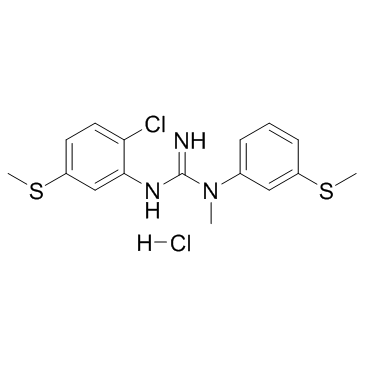CNS-5161 hydrochloride
Modify Date: 2024-01-11 09:18:49

CNS-5161 hydrochloride structure
|
Common Name | CNS-5161 hydrochloride | ||
|---|---|---|---|---|
| CAS Number | 160756-38-7 | Molecular Weight | 388.378 | |
| Density | N/A | Boiling Point | N/A | |
| Molecular Formula | C16H19Cl2N3S2 | Melting Point | N/A | |
| MSDS | N/A | Flash Point | N/A | |
Use of CNS-5161 hydrochlorideCNS-5161 hydrochloride is a novel NMDA ion-channel antagonist that interacts with the NMDA receptor/ion channel site to produce a noncompetitive blockade of the actions of glutamate. |
| Name | CNS-5161 hydrochloride |
|---|---|
| Synonym | More Synonyms |
| Description | CNS-5161 hydrochloride is a novel NMDA ion-channel antagonist that interacts with the NMDA receptor/ion channel site to produce a noncompetitive blockade of the actions of glutamate. |
|---|---|
| Related Catalog | |
| Target |
NMDA receptor/ion channel[1] |
| In Vitro | CNS-5161 (CNS 5161) is a novel and selective noncompetitive antagonist of the NMDA subset of glutamate receptors in the mammalian brain. CNS-5161 has potent inhibitory activity in vitro at the NMDA ion channel and is able to displace [3H] MK-801 binding with a Ki of 1.8 nM in synaptosomal membrane preparations from rat brain[1]. |
| In Vivo | In the neonatal rat NMDA excitotoxicity model in vivo, CNS-5161 (CNS 5161) protects against the necrotic effects of exogenous N-methyl-D-aspartate with an ED80 of 4 mg/kg by the intraperitoneal (i.p.) route. CNS-5161 also shows a 91% inhibition of audiogenic seizures in DBA/2 mice at 4 mg/kg i.p., and has a neuroprotective effect following hypoxix/ischaemic brain injury in neonatal rats[1]. |
| References |
| Molecular Formula | C16H19Cl2N3S2 |
|---|---|
| Molecular Weight | 388.378 |
| Exact Mass | 387.039734 |
| 2-[2-Chloro-5-(methylsulfanyl)phenyl]-1-methyl-1-[3-(methylsulfanyl)phenyl]guanidine hydrochloride (1:1) |
| Guanidine, N''-[2-chloro-5-(methylthio)phenyl]-N-methyl-N-[3-(methylthio)phenyl]-, hydrochloride (1:1) |